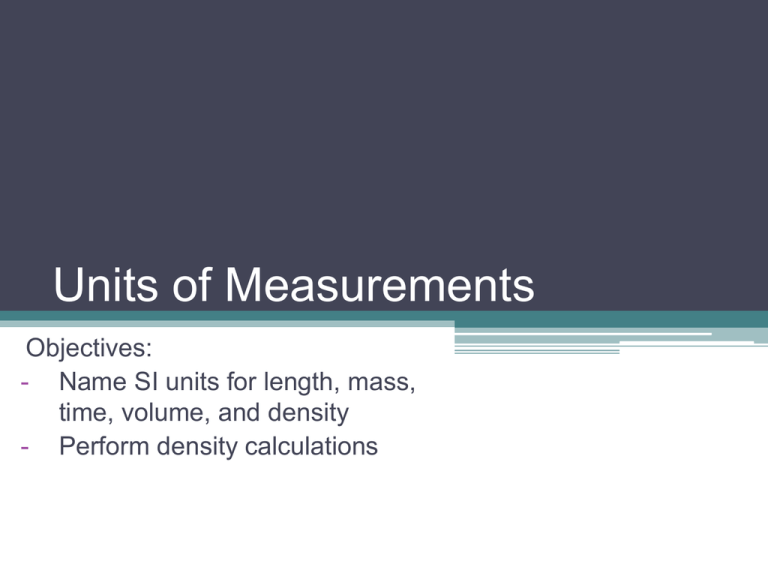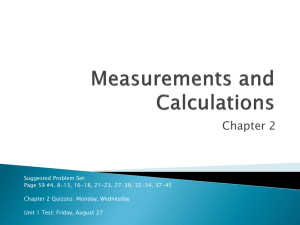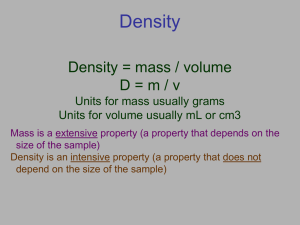Units of Measurements
advertisement

Units of Measurements Objectives: - Name SI units for length, mass, time, volume, and density - Perform density calculations SI Measurements • International standard of measurement • Defined in terms of standards of measurement SI Base Units SI Base Units Quantity Symbol Base Unit Abbrev. length l meter m mass m kilogram kg time t second s temperature T Kelvin K Metric Prefixes • Prefixes are added to the names of SI base units to represent quantities that are larger or smaller than the base units SI Prefixes Prefix Scientific notation Meaning mega (M) 106 1 000 000 kilo (k) 103 1 000 hecto (h) 102 100 deka (da) 101 10 Base Unit 100 1 deci (d) 10-1 0.1 centi (c) 10-2 0.01 milli (m) 10-3 0.001 micro () 10-6 0.000 001 nano (n) 10-9 0.000 000 001 Derived Units • Combinations of SI base units • Produced by multiplying or dividing standard units • Ex: ▫ Area (m2) length x width ▫ Volume (m3 or cm3) length x length x length ▫ Density (kg/m3 or g/cm3) mass per volume • Volume ▫ Volume: the amount of space occupied by an object ▫ SI unit = cm3 ▫ Volumes of liquids and gases are often measured by a non-SI unit called the liter (L) 1 L = 1000 cm3 ▫ mL is used for smaller volumes 1000 mL = 1 L ▫ What can you tell me about the relationship between mL and cm3? 1000 mL = 1L = 1000 cm3 1 mL = 1 cm3 • Density ▫ Density: the ratio of mass to volume or mass divided by volume Density = mass Volume or D = m V ▫ A characteristic property of a substance Can be used as one property to help identify a substance ▫ SI unit = kg/m3 ▫ Units often used = g/cm3 or g/mL Mass (g) slope = Volume (cm3) ∆y ∆x = m V =D • Sample Problem ▫ A sample of aluminum has a mass of 8.4 g. The volume of the sample is 3.1 cm3. Calculate the density of the aluminum. ▫ Given: m = 8.4 g V = 3.1 cm3 ▫ Unknown: D=? ▫ Solve: m D= D= V 8.4 g 3.1 cm3 = 2.7 g/cm3 • Sample Problem #2 ▫ An object has a volume of 825 cm3 and has a density of 13.6 g/cm3. Find its mass. ▫ Given: V = 825 cm3 D = 13.6 g/cm3 ▫ Unknown: m=? ▫ Solve: m D= m=DxV V m = (13.6 g/cm3)(825 cm3) m = 11,220 g or 1.12 x 104 g • You Try! ▫ What is the density of a block of marble that occupies 310 cm3 and has a mass of 853 g? 2.75 g/cm3 ▫ Diamond has a density of 3.26 g/cm3. What is the mass of a diamond that has a volume of 0.350 cm3? 1.14 g ▫ What is the volume of a sample of liquid mercury that has a mass of 76.2 g, given that the density of mercury is 13.6 g/mL? 5.60 mL Practice Problems Density 1. The mass of a sample of aluminum is 4.82 g. The same sample of aluminum occupies a volume of 3.08 mL. Determine the density of the aluminum sample. 2. A small gold nugget has a volume of 0.87 cm3. What is its mass if the density of gold is 19.3 g/cm3? 3. What volume is occupied by 35.2 g of carbon tetrachloride if its density is 1.60 g/mL? 4. A cork occupying a volume of 5.23 mL is measured to have a mass of 14.7 g. What is the density of the cork?







